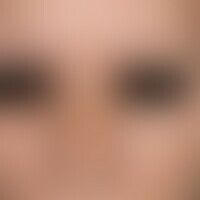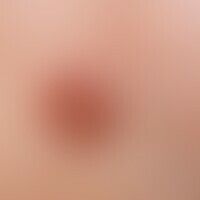Image diagnoses for "Nose"
58 results with 110 images
Results forNose

Hidrocystoma D23.L
Hidrocystoma: Survey image: Since about 2 years gradually developing, disseminated, colorless and black-blue, painless nodules of 0.1-0.3 cm size at the bridge of the nose of a 14-year-old patient.

Hidrocystoma D23.L
Hidrocystoma. detail enlargement: multiple, chronically stationary (no noticeable growth), black-blue, 0.1-0.3 cm measuring elevation; small white comedones are also visible.

Adenoma sebaceum Q85.1
Adenoma sebaceum: in the 65-year-old female patient, skin-coloured to reddish-brownish, densely packed papules and plaques with centrofacial accentuation have existed since childhood; the misleading term "Adenoma sebaceum" refers to the characteristic centrofacially localised angiofibromas occurring in the context of tuberous sclerosis complex (Pringle-Bourneville phacomatosis).

Localized Cutaneous Nodular Amyloidosis E85.8
Amyloidosis cutis nodularis atrophicans: Solitary, soft, brownish-yellowish nodule on the nostril (histologically confirmed as amyloidosis cutis) in a 27-year-old man without clinically detectable systemic amyloidosis.

Basal cell carcinoma (overview) C44.-
Basal cell carcinoma ulcerated: large-area, nodular, non-painful basal cell carcinoma, untreated for years. initially surface intact nodule. for 1/2 year crust formation with ulcer formation. HIV-infected person.

Basal cell carcinoma nodular C44.L
Basal cell carcinoma, nodular, sharply defined, shiny, smooth tumor interspersed with bizarre "tumor vessels", which are particularly prominent in this nodular basal cell carcinoma and play an important role in the diagnosis.

Basal cell carcinoma nodular C44.L
Basal cell carcinoma, nodular. solitary, 1.0 x 1.2 cm large, broad-based, firm, painless nodule, with a shiny, smooth parchment-like surface covered by ectatic, bizarre vessels. Note: There is no follicular structure on the surface of the nodule (compare surrounding skin of the bridge of the nose with the protruding follicles).

Basal cell carcinoma pigmented C44.L

Basal cell carcinoma sclerodermiformes C44.L
Basal cell carcinoma, sclerodermiformes. 1 cm diameter of irritation-free, almost skin-coloured plaque with irregular surface in a 58-year-old patient. There are single, fine telangiectases on the bridge of the nose.

Basal cell carcinoma sclerodermiformes C44.L

Basal cell carcinoma sclerodermiformes C44.L

Birt-hogg-dubé syndrome D23.-
Birt-Hogg-Dubé syndrome: Multiple, skin-coloured, flesh-coloured and whitish, partly waxy, relatively coarse, 2?5 mm large, hemispherical asymptomatic papules in the nose and cheek area of a 47-year-old female patient.

Boils L02.92
Solitary, acutely appearing, increasing for 3 days, blurred, spontaneously painful, red, smooth lump with central pus clot.

Infant haemangioma (overview) D18.01

Keratoakanthoma (overview) D23.-
Keratoakanthoma, classic type, short term, hard, reddish, hard, reddish, centrally dented, strongly keratinized lump with isolated telangiectasias on the surface, grown within 4 weeks, measuring about 1.5 cm, in a 51-year-old female patient.

Komedo L73.8
Comedo:multiple, chronically stationary, 0.5-1 mm large, firm, asymptomatic, grey, rough follicular papules with enlarged follicles, localized in the nasolabial fold; sebaceous content can be expressed on pressure.

Lentigo maligna melanoma C43.L

Angiomyxoma cutaneous D23.-
Myxoma, cutaneous skin-colored nodules with surrounding redness at the nostril of a 36-year-old patient.

Nevus araneus I78.1
Naevus araneus: in the 43-year-old man there are isolated red spots, 0.1-0.2 cm in size, and red, smooth papules with a central arterial nodule and radiating capillary ectasia.

Nevus melanocytic (overview) D22.-
Common melanocytic nevus. dermal type. acquired, known for decades, solitary, chronically inpatient, 0.4 cm tall, sharply defined, soft, symptomless, skin-colored, smooth papules. follicular openings are visible.

Nevus melanocytic (overview) D22.-
Nevus, melanocytic. type: Congenital melanocytic nevus. solitary, chronically stationary, constant size for 12 months, indolent, sharply defined, axisymmetric, 0.6 cm diameter, dark brown, smooth nodule.

Nasal papilla fibrosus D23.3
Nasal papule, fibrous n odule, about 3 years ago, about 4 mm in diameter, with a smooth surface and single telangiectasias, paranasal right in a 64-year-old patient.

Psoriasis vulgaris L40.00
Psoriasis vulgaris. abbortive form with infestation of the nostrils on both sides. The clinical picture is clinically relevant in that rhagades and pain occur. Local therapy is laborious.

Psoriasis vulgaris L40.00
Psoriasis vulgaris: Erythematous, scaly plaque on the tip of the nose of a 34-year-old woman, which appeared for the first time about 1.5 years ago and measured about 1.5 cm.
